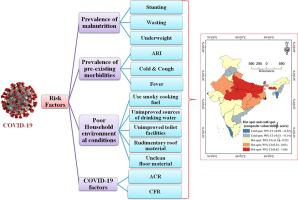当前位置:
X-MOL 学术
›
Children and Youth Services Review
›
论文详情
Our official English website, www.x-mol.net, welcomes your feedback! (Note: you will need to create a separate account there.)
Do malnutrition, pre-existing morbidities, and poor household environmental conditions aggravate susceptibility to Coronavirus disease (COVID-19)? A study on under-five children in India
Children and Youth Services Review ( IF 2.519 ) Pub Date : 2021-06-23 , DOI: 10.1016/j.childyouth.2021.105962 Jay Saha 1 , Pradip Chouhan 1
Children and Youth Services Review ( IF 2.519 ) Pub Date : 2021-06-23 , DOI: 10.1016/j.childyouth.2021.105962 Jay Saha 1 , Pradip Chouhan 1
Affiliation

|
The novel Coronavirus disease 2019 (2019-nCoV) outbreak, caused by severe acute respiratory syndrome Coronavirus-2 (SARS-CoV-2), has become the worst serious global risk to humanity in the last century and linked with various risk factors. To find out the risk zone associated with Coronavirus disease among children under-five age using malnourished status, pre-existing morbidity conditions, poor household environmental conditions, and also with case fatality rate (CFR) and active case rate (ACR) of COVID-19 in India. Data was collected from the 4th round of the National Family Health Survey (NFHS)-4, 2015–16, and CFR and ACR of COVID-19 related data collected from the Ministry of Health and Family Welfare (MoHFW) on 18th May 2020. Mean, standard deviation, and Z-score statistical methods have been employed to identify the risk factors zone and Hot Spot analysis (Getis-Ord Gi) has been done. The states and union territories (UTs) which have a high composite vulnerability score (CVS) of COVID-19 among under-five children are in Meghalaya (CVS = 1), Uttar Pradesh (CVS = 0.93), Jharkhand (CVS = 0.86), Bihar (CVS = 0.74), Madhya Pradesh (CVS = 0.74), and Odisha (CVS = 0.55). The states and UTs which have low composite vulnerability score of COVID-19 among under-five children are in Sikkim (CVS = -0.90), Daman & Diu (CVS = -0.76) Lakshadweep (CVS = -0.74), Kerala (CVS = -0.72), Chandigarh (CVS = -0.71). The COVID-19 high-risk zones (hot spot: 99% Confidence interval [CI]) were observed in Madhya Pradesh, Uttar Pradesh, Jharkhand, Bihar, and Meghalaya states of India, which are spatially high clustered and the low-risk zones (cold spot: 95% CI) were observed in Kerala, Mizoram states of India. Well-built public health measures, including rapidly searching in high focus areas and testing of COVID-19, should be performed in vulnerable regions of COVID-19.
中文翻译:

营养不良、已有疾病和不良的家庭环境条件是否会加剧对冠状病毒病(COVID-19)的易感性?针对印度五岁以下儿童的研究
由严重急性呼吸综合征冠状病毒2(SARS-CoV-2)引起的2019新型冠状病毒病(2019-nCoV)爆发,已成为上世纪人类面临的最严重的全球风险,并与多种危险因素相关。利用营养不良状况、既往发病情况、不良家庭环境条件以及新冠肺炎病死率 (CFR) 和活跃病例率 (ACR) 来找出五岁以下儿童与新冠病毒疾病相关的风险区域。 19 在印度。数据收集自 2015-16 年第四轮全国家庭健康调查 (NFHS)-4,以及 2020 年 5 月 18 日从卫生和家庭福利部 (MoHFW) 收集的 COVID-19 相关数据的 CFR 和 ACR。采用平均值、标准差和 Z 分数统计方法来识别风险因素区域,并进行了热点分析 (Getis-Ord Gi)。五岁以下儿童的 COVID-19 综合脆弱性评分 (CVS) 较高的州和联邦直辖区 (UT) 包括梅加拉亚邦 (CVS = 1)、北方邦 (CVS = 0.93)、贾坎德邦 (CVS = 0.86) 、比哈尔邦(CVS = 0.74)、中央邦(CVS = 0.74)和奥里萨邦(CVS = 0.55)。五岁以下儿童的 COVID-19 综合脆弱性评分较低的州和联邦直辖区包括锡金 (CVS = -0.90)、达曼和迪乌 (CVS = -0.76)、拉克沙群岛 (CVS = -0.74)、喀拉拉邦 (CVS = -0.72),昌迪加尔(CVS = -0.71)。在印度的中央邦、北方邦、贾坎德邦、比哈尔邦和梅加拉亚邦观察到了 COVID-19 高风险区(热点:99% 置信区间 [CI]),这些地区在空间上高度聚集,而低风险区(冷点:95% CI)在印度喀拉拉邦、米佐拉姆邦观察到。应在 COVID-19 的易感地区采取完善的公共卫生措施,包括在高度关注的区域进行快速搜索和对 COVID-19 进行检测。
更新日期:2021-06-23
中文翻译:

营养不良、已有疾病和不良的家庭环境条件是否会加剧对冠状病毒病(COVID-19)的易感性?针对印度五岁以下儿童的研究
由严重急性呼吸综合征冠状病毒2(SARS-CoV-2)引起的2019新型冠状病毒病(2019-nCoV)爆发,已成为上世纪人类面临的最严重的全球风险,并与多种危险因素相关。利用营养不良状况、既往发病情况、不良家庭环境条件以及新冠肺炎病死率 (CFR) 和活跃病例率 (ACR) 来找出五岁以下儿童与新冠病毒疾病相关的风险区域。 19 在印度。数据收集自 2015-16 年第四轮全国家庭健康调查 (NFHS)-4,以及 2020 年 5 月 18 日从卫生和家庭福利部 (MoHFW) 收集的 COVID-19 相关数据的 CFR 和 ACR。采用平均值、标准差和 Z 分数统计方法来识别风险因素区域,并进行了热点分析 (Getis-Ord Gi)。五岁以下儿童的 COVID-19 综合脆弱性评分 (CVS) 较高的州和联邦直辖区 (UT) 包括梅加拉亚邦 (CVS = 1)、北方邦 (CVS = 0.93)、贾坎德邦 (CVS = 0.86) 、比哈尔邦(CVS = 0.74)、中央邦(CVS = 0.74)和奥里萨邦(CVS = 0.55)。五岁以下儿童的 COVID-19 综合脆弱性评分较低的州和联邦直辖区包括锡金 (CVS = -0.90)、达曼和迪乌 (CVS = -0.76)、拉克沙群岛 (CVS = -0.74)、喀拉拉邦 (CVS = -0.72),昌迪加尔(CVS = -0.71)。在印度的中央邦、北方邦、贾坎德邦、比哈尔邦和梅加拉亚邦观察到了 COVID-19 高风险区(热点:99% 置信区间 [CI]),这些地区在空间上高度聚集,而低风险区(冷点:95% CI)在印度喀拉拉邦、米佐拉姆邦观察到。应在 COVID-19 的易感地区采取完善的公共卫生措施,包括在高度关注的区域进行快速搜索和对 COVID-19 进行检测。



























 京公网安备 11010802027423号
京公网安备 11010802027423号